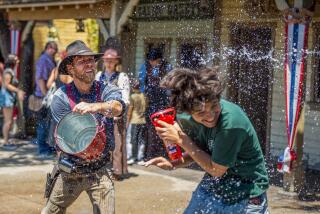Amusement company’s long ride comes to an end
- Share via
The concrete Indian on the forklift struck a precarious pose as he moved through a crowd of rummagers scouting the remains of Bud Hurlbut’s workshop in Buena Park. From behind the wheel, Lonnie Lloyd waved everyone aside as he guided the 6-foot, 6-inch statue into a U-Haul van. Its new owners shimmied it against a wall.
Toys, props, tools and memorabilia at Hurlbut Amusement Co. moved fast during the recent three-day sale, and Lloyd tried not to be sentimental.
“If I let it affect me, I wouldn’t be here,” he said, even as he got a little teary-eyed.
His boss, Wendell “Bud” Hurlbut, died last year at 92. For the last five decades, the workshop had built and refurbished carousels, miniature train rides, antique car rides and countless accessories destined for amusement parks around the world. Hurlbut designed them, and Lloyd — together with welders, fabricators and machinists — assembled and maintained them.
Now everything had to go. Lloyd, 57, never imagined it would end this way. Hired as a maintenance worker 31 years ago, he became foreman of the shop and a friend to the owner. He remembers visiting Hurlbut at home last year after his release from the hospital.
“You have $10 million and four years of work in front of you,” the old man told him. “Go back and build. When I get out of this bed, we’ll give them hell.”
Four days later, he was dead, and with no children, his estate soon lay in the hands of seven charities and 26 beneficiaries. Last June, the property — two acres within earshot of Knott’s Berry Farm — was sold for $3.63 million to Buena Park. Officials hope to see it developed into a hotel and restaurants.
Lloyd and friends in the amusement park industry call it the end of an era. Hurlbut was their last link to Walter Knott and Walt Disney, who saw in the open fields of Orange County a chance to reinvent the traveling carnival into theme parks such as the world had never imagined.
If history books highlight the achievements of Disney and Knott and give only passing notice to Hurlbut, it is because he was mostly content to be known for his rides. All told: 12 for Knott’s and about 50 trains and countless other entertainments for Castle Park, the amusement park in Riverside that he built and later sold.
His greatest and most lasting achievement is the Calico Mine Ride at Knott’s. Completed in 1960, it enacted a descent into a mountain mine with steam pots, underground lakes and a dynamite explosion at the end. Disney’s Matterhorn was a shadow of its complexity.
In its first two years, the ride drew 3.5 million visitors and grossed more than $1.5 million.
Two months’ planning went into this sale. The contents of 13 semi-trailers on the property were organized and sorted, and as at all estate sales, everything had its price.
Carousel horse: $5,600. Storage shed: $1,500. Painted collage of Hurlbut’s rides at Knott’s: $1,500. Power hammer: $1,400. Hurlbut’s roll-top desk: $750. Pallet of scrap iron: $400. Old Coke machine: $300.
The take at the end, according to Vivien Hessel, who managed the event, was more than $100,000.
One collector, Ken Stack, bought everything in Hurlbut’s office and plans to re-create the space in a museum devoted to the amusement park industry. Others were happy to grab what they could.
When the doors opened, Todd and Danielle Ray, owners of the Venice Beach Freakshow, ran through the shop, slapping sold stickers on anything that caught their eye: a knee-high wooden rabbit and lion, a cartouche with a jester’s face — and two concrete statues of cigar store Indians.
Larry Kuester walked out the door with an ore car slightly bigger than a shoe box. He swore that as a child he saw it filled with candy on the counter of the general store in Knott’s Ghost Town.
Deborah Miller filled a shopping bag with issues of Modern Machine Shop from the ‘70s. She hoped to get them up on EBay soon.
Largely self-taught, Hurlbut lived in a world of ideas made real by craftsmen armed with oil and grease, calipers, mills and lathes. Everything they needed was here: a wood shop, a welding shop, a sheet metal shop and a blacksmith shop.
Toward the end, the business was losing half a million dollars a year, said Philip Coulson, the trustee of the estate, but Hurlbut wasn’t overly concerned. When someone once suggested that he retire and play more golf, Hurlbut replied that this shop was his golf game.
Coulson misses his friend, the man who kept in his wallet a cheat sheet with 10 of his favorite jokes. But he doesn’t read too much significance into the closing of the company. Businesses look forward, he says; only people look backward.
“End of era?” he asks. “No, it’s the end of a man’s life.”
On the last day of the sale, Lloyd was back on the forklift. A few friends who own traveling carnivals needed help loading the scraps they had bought. This would be their last gathering at the workshop. The building would soon be locked and deserted; one day it would be razed.
Lloyd plans to keep busy. In a week he would be in Hawaii converting two trains on the Dole Plantation from diesel to electricity, and once back, he’ll open a workshop in Stanton.
With the pull of a lever, he positioned a load of fencing on the bed of a truck. In the distance, he could hear the bell on the steam engine at Knott’s, its clanging barely discernible above the screams of thrill riders.
More to Read
Sign up for Essential California
The most important California stories and recommendations in your inbox every morning.
You may occasionally receive promotional content from the Los Angeles Times.











